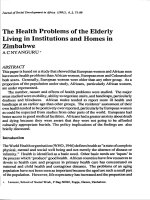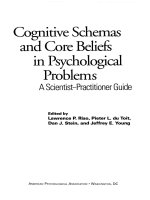150 ECG Problems
Bạn đang xem bản rút gọn của tài liệu. Xem và tải ngay bản đầy đủ của tài liệu tại đây (35.36 MB, 316 trang )
SECOND EDITION
CO
o
CD
uo
Commissioning Editor: Laurence Hunter
Project Development Manager: Lynn Watt and Helius
Project Manager: Nancy Arnott
Designer: Erik Bigland and Helius
Illustrator: Helius and Chartwell Illustrators
Illustration Manager: Bruce Hogarth
150
ECG
PROBLEMS
John R. Hampton
DM MA DPhil FRCP FFPM FESC
Emeritus Professor of Cardiology
University of Nottingham
Nottingham
UK
CHURCHILL
LIVINGSTONE
EDINBURGH LONDON NEW YORK OXFORD PHILADELPHIA
ST LOUIS SYDNEY TORONTO 2003
CHURCHILL LIVINGSTONE An imprint of Elsevier Science Limited
© Pearson Professional 1997
©2003, Elsevier Science Limited. All rights reserved.
The right of Professor J. R. Hampton to be identified as author of this work has been asserted by
him in accordance with the Copyright, Designs and Patents Act 1988.
No part of this publication may be reproduced, stored in a retrieval system, or transmitted in any
form or by any means, electronic, mechanical, photocopying, recording or otherwise, without either
the prior permission of the publishers or a licence permitting restricted copying in the United
Kingdom issued by the Copyright Licensing Agency, 90 Tottenham Court Road, London W1T 4LP.
Permissions may be sought directly from Elsevier's Health Sciences Rights Department in Philadelphia,
USA: phone: (+1) 215 238 7869, fax: (+1) 215 238 2239, e-mail: ).
You may also complete your request on-line via the Elsevier Science homepage
(), by selecting 'Customer Support' and then 'Obtaining Permissions'.
First edition 1997
Second edition 2003
Reprinted 2003
Standard edition ISBN 0 443 072485
International edition ISBN 0 443 072493
British Library Cataloguing in Publication Data
A catalogue record for this book is available from the British Library
Library of Congress Cataloging in Publication Data
A catalog record for this book is available from the Library of Congress
Note
Medical knowledge is constantly changing. Standard safety precautions must be followed, but as
new research and clinical experience broaden our knowledge, changes in treatment and drug
therapy may become necessary or appropriate. Readers are advised to check the most current
product information provided by the manufacturer of each drug to be administered to verify the
recommended dose, the method and duration of administration, and contraindications. It is the
responsibility of the practitioner, relying on experience and knowledge of the patient, to determine
dosages and the best treatment for each individual patient. Neither the Publisher nor the author
assumes any liability for any injury and/or damage to persons or property arising from this
publication.
your source for books,
ELSEVIER journals and multimedia
S C I E N C E in the health sciences
www.elsevierhealth.com
The
publisher's
policy is to use
paper manufactured
from sustainable forests
Printed in China
P/02
Preface
Learning about ECG interpretation from books such as The ECG
Made Easy or The ECG in Practice is fine so far as it goes, but it
never goes far enough. As with most of medicine, there is no
substitute for experience, and to make the best use of the ECG
there is no substitute for reviewing large numbers of them. ECGs
need to be seen in the context of the patient from whom they
were recorded. You have to learn to appreciate the variations both
of normality and of the patterns associated with different diseases,
and to think about how the ECG can help patient management.
Although no book can substitute for practical experience, 250
ECG Problems goes a stage nearer the clinical world than books that
simply aim to teach ECG interpretation. It presents 150 clinical
problems in the shape of simple case histories, together with the
relevant ECG. It invites the reader to interpret the ECG in the light
of the clinical evidence provided, and to decide on a course of
action before looking at the answer. Having seen the answers, the
reader may feel the need for more information, so each one is crossreferenced to The ECG Made Easy or The ECG in Practice.
The ECGs in 250 ECG Problems range from the simple to the
complex. About one-third of the problems are of a standard that a
medical student should be able to cope with, and will be answered
correctly by anyone who has read The ECG Made Easy. A house
officer, specialist nurse or paramedic should get another third right,
and will certainly be able to do so if they have read The ECG in
Practice. The remainder should challenge the MRCP candidate.
As a very rough guide to the level of difficulty, each answer is
given one, two or three stars (see the summary box of each
answer): one star represents the easiest records, and three stars the
most difficult.
The ECGs are arranged in random order, not in order of
difficulty: this is to maintain interest and to challenge the reader to
attempt an interpretation before looking at the star rating. This is,
after all, the real-life situation: one never knows which patient will
be easy and which will be difficult to diagnose or treat.
150 ECG Problems is the successor to 100 ECG Problems, published
in 1997. The popularity of the latter has encouraged me to include
more examples of common abnormalities and also some problems
for which there was previously no space. I hope the reader will find
250 ECG Problems an entertaining and an easy way to learn and
revise.
John R. Hampton
Nottingham
The symbols | ME I and | IP | denote cross-references to useful
information in the books The ECG Made Easy, 6th edn, and The
ECG in Practice, 4th edn, respectively (written by Professor
Hampton and published by Elsevier Science).
ECG 1 This ECG was recorded from a 25-year-old pregnant woman who complained of an irregular heart beat.
Auscultation revealed a soft systolic murmur but her heart was otherwise normal. What does the ECG show and what
^
ANSWER 1
The ECG shows:
•
•
•
•
Sinus rhythm
Ventricular extrasystoles
Normal axis
Normal QRS complexes and T waves
Clinical interpretation
The extrasystoles are fairly frequent but the ECG
is otherwise normal. Ventricular extrasystoles are
very common in pregnancy, and systolic murmurs
are almost universal. Her heart is almost certainly
normal.
What to do
Remember that anaemia is a common cause of a
systolic murmur. Doubts about the significance of
the murmur can be resolved by echocardiography,
but this need not be performed in every pregnant
woman - it is best reserved for the investigation of
apparently important murmurs that persist after
delivery. The patient should be reassured and the
extrasystoles left untreated.
Summary
Sinus rhythm with ventricular extrasystoles.
rn
n
ECG 2 A 60-year-old man was seen as an out-patient, complaining of rather vague central chest pain on exertion.
He had never had pain at rest. What does this ECG show and what would vou do next?
®
m
I
ANSWER
ANSWER 32
The
The ECG
ECGshows:
shows:
•• Complete
heart block
Sinus rhythm
•• Ventricular
rate 45/min
Normal axis
• Small Q waves in leads II, III, VF
interpretation
Clinical
• Biphasic
T waves in leads II, V6; inverted T
In complete
block
waves in heart
leads III,
VFthere is no relationship
between
with
a rate Vof1 -70/min)
the
P
waves
• Markedly peaked T(here
waves
in leads
V2
and the QRS complexes. The ventricular 'escape'
wide QRS complexes and abnormal T
rhythm
Clinicalhas
interpretation
further
interpretation
of together
the ECG is
waves.
No
The Q waves in the
inferior leads,
possible.
with inverted T waves, point to an old inferior
myocardial infarction. While symmetrically
What
peakedtoT do
waves in the anterior leads can be
thetoabsence
of a history
suggesting
a they
myocardial
In
due
hyperkalaemia,
or to
ischaemia,
are
womanvariant.
almost certainly has chronic
infarction,
frequentlythis
a normal
heart block: the fall may or may not have been
due
Stokes-Adams
attack. She needs a
to ato
What
do
permanent
ideally
The patientpacemaker,
seems to have
hadimmediately
a myocardialto
save
the morbidity
of firstintemporary,
andby
then
infarction
at some point
the past, and
insertion.
If permanent
permanent,
implication pacemaker
his vague chest
pain may
be due
is not
possible Attention
immediately,
a be
temporary
pacing
to cardiac
ischaemia.
must
paid to
be needed
pacemaker
risk factorswill
(smoking,
bloodpreoperatively.
pressure, plasma
cholesterol), and he probably needs long-term
treatment with aspirin and a statin. An exercise
test will be the best way of deciding whether he
has coronary disease that merits angiography.
Summary
Summary
Complete
(third
degree) infarction.
heart block.
Old inferior
myocardial
IfJE I See
p. 33
Seep.
103
lp~~]1 Seep.
See p.213
238
EEH
An 80-year-old woman, who had previously had a few attacks of dizziness, fell and broke her hip. Sh
found to have a slow pulse, and this is her ECG. The surgeons want to operate as soon as possible but the anaesthe
is unhappy. What does the ECG show and what should be done?n
ANSWER 3
The ECG shows:
• Complete heart block
• Ventricular rate 45/min
Clinical interpretation
rate 45/min
In complete heart block there is• noVentricular
relationship
between the P waves (here with a rate of 70/min)
and the QRS complexes. The ventricular 'escape'
rhythm has wide QRS complexes and abnormal T
waves. No further interpretation of the ECG is
possible.
What to do
possible.a myocardial
In the absence of a history suggesting
infarction, this woman almost certainly has chronic
to do
heart block: the fall may or mayWhat
not have
been
due to a Stokes-Adams attack. She needs a
permanent pacemaker, ideally immediately to
save the morbidity of first temporary, and then
permanent, pacemaker insertion. If permanent
pacing is not possible immediately, a temporary
pacemaker will be needed preoperatively.
Summary
Complete (third degree) heart block.
IfJ
See p. 33
lp~~]
Seep. 213
^3ZH A 50-year-old man is seen in the A & E department with severe central chest pain which has been present for
18 h. What does this ECG show and what would you do?«JB
ANSWER 4
\
The ECG shows:
•
•
•
•
•
Sinus rhythm
Normal axis
Q waves in leads V2-V4
Raised ST segments in leads V2-V4
Inverted T waves in leads I, VL, V2-V6
Clinical interpretation
This is a classic acute anterior myocardial
infarction.
What to do
More than 18 h have elapsed since the onset of
pain, so this patient is outside the conventional
limit for thrombolysis. Nevertheless, if he is still in
pain and still looks unwell, thrombolytic treatment
should be given unless there are good reasons not
to do so. In any case he should be given pain relief
and aspirin, and must be admitted to hospital for
observation.
Summary
Acute anterior myocardial infarction.
IE | See p. 96
IP I Seep. 239
ECG 5 This ECGwas recorded from a 60-year-old woman with rheumatic heart disease. She had been in heart
failure, but this had been treated and she was no longer breathless. What does the ECGshow and what question might
you ask her?
ANSWER 5
the effects of digoxin. If in doubt, the serum
digoxin level is easily measured.
The ECG shows:
• Atrial fibrillation with a ventricular rate of
60-65/min
• Normal axis
• Normal QRS complexes
• Prominent U wave in lead V2
• Downward-sloping ST segments, best seen in
leads V5-V6
Clinical interpretation
The downward-sloping ST segments (the 'reverse
tick') indicate that digoxin has been given. The
ventricular rate seems well-controlled. The
prominent U waves in lead V2 could indicate
hypokalaemia.
What to do
Ask the patient about her appetite: the earliest
symptom of digoxin toxicity is appetite loss,
followed by nausea and vomiting. If the patient
is being treated with diuretics, check the serum
potassium level - a low potassium level potentiates
Summary
Atriat fibrillation with digoxin effect.
IE j See pp. 78 and 107
IP I See pp. 367 and 373
1
ECG 6 A 26-year-old woman, who has complained of palpitations in the past, is admitted via the A & E department^
with palpitations. What does the ECGshow and what should you do
ANSWER 6
The ECG shows:
•
•
•
•
•
Narrow-complex tachycardia, rate about 200/min
No P waves visible
Normal axis
Regular QRS complexes
Normal QRS complexes, ST segments and T
waves
adenosine should be given by bolus injection.
Adenosine has a very short half-life, but can cause
flushing and occasionally asthma. If adenosine
proves unsuccessful, verapamil 5-10 mg given by
bolus injection will usually restore sinus rhythm.
Otherwise, DC cardioversion is indicated.
Clinical interpretation
This is a supraventricular tachycardia, and since
no P waves are visible this is a junctional, or
atrioventricular nodal, tachycardia.
What to do
Junctional tachycardia is the commonest form
of paroxysmal tachycardia in young people, and
presumably explains her previous episodes of
palpitations. Attacks of junctional tachycardia
may be terminated by any of the manoeuvres that
lead to vagal stimulation - Valsalva's manoeuvre,
carotid sinus pressure, or immersion of the face in
cold water. If these are unsuccessful, intravenous
Summary
*
Junctional (atrioventricular nodal re-entry) tachycardia.
See p. 72
See p. 159
ECG 7 This ECG was recorded in the A & E department from a 55-year-old man who had had chest pain at rest for
6 h. There were no abnormal physical findings. What does the trace show, and how would you manage him?
ANSWER 7
The ECG shows:
•
•
•
•
Sinus rhythm
Normal axis
Normal QRS complexes
ST segment depression - horizontal in leads
V3-V4, downward-sloping in leads I, VL, V5-V6
Clinical interpretation
This ECG shows anterior and lateral ischaemia
without evidence of infarction. Taken with the
clinical history, the diagnosis is clearly 'unstable'
angina.
What to do
There is no evidence of any benefit from
thrombolysis. The patient should be given
aspirin and intravenous heparin and nitrates.
At the time the record was taken, he had a
sinus tachycardia (at a rate of about 130/min)
and if this does not settle quickly, intravenous
beta-blockade help.
Summary
Anterolateral ischaemia.
I "Mil
See p 102
See p. 267
ECG 8 These three rhythm strips (all lead II) came from the ECGs of three different patients. They were all in their
eighties, and all complained of breathlessness. What other symptoms might they have had, what diagnoses would you
consider, and what treatment is possible?
ANSWER 8
The ECGs show:
(a) No P waves can be seen but the baseline
is irregular; the QRS complexes are broad,
regular, and slow. This is atrial fibrillation with
complete block.
(b) In the conducted beats the PR interval is
constant, so this is sinus rhythm with second
degree (2:1) block. The second small deflection
after the R wave is not a P wave, but is part of
the QRS complex.
(c) There is no fixed relationship between the
P waves and the QRS complexes, so this is
complete (third degree) heart block.
Clinical interpretation
Single ECG leads can only be used to identify the
rhythm, and further interpretation is unreliable.
What to do
All the patients are probably suffering the effects
of their bradycardia; additional symptoms might
be angina, dizziness, and collapse (Stokes-Adams
attacks). In each case the likely diagnosis is
idiopathic fibrosis of the conducting system, but
almost all cardiac conditions can be associated
with heart block - rheumatic disease, ischaemia,
cardiomyopathy, trauma, metastases and so on.
In the elderly, heart block is often associated with
a calcified aortic valve. Whatever their age, such
patients benefit from a permanent pacemaker.
Summary
(a) Atrial fibrillation and complete block.
(b) Second degree (2:1) block.
(c) Complete (third degree) block.
«_]
See p. 30
l|»~l
See p. 199
Co
[j^^Q A 40-year-old woman is referred to the out-patient department because of increasing breathlessness. What
does this ECG show, what physical signs might you expect, and what might be the underlying problem? What might you
do?
ANSWER 9
The ECG shows:
•
•
•
•
•
•
Sinus rhythm
Peaked P waves, best seen in lead II
Right axis deviation
Dominant R waves in lead Vj
Deep S waves in lead V6
Inverted T waves in leads II, III, VF, V1-V3
Clinical interpretation
This combination of right axis deviation,
dominant R waves in lead Vl and inverted T
waves spreading from the right side of the heart,
is classical of severe right ventricular hypertrophy.
Right ventricular hypertrophy can result from
congenital heart disease, or from pulmonary
hypertension secondary to mitral valve disease,
lung disease, or pulmonary embolism. The
physical signs of right hypertrophy are a left
parasternal heave and a displaced but diffuse
apex beat. There may be a loud pulmonary
second sound. The jugular venous pressure may
be elevated and a 'flicking A' wave in the jugular
venous pulse is characteristic.
What to do
The two main causes of pulmonary hypertension
of this degree in a 40-year-old woman are
recurrent pulmonary emboli, and primary
pulmonary hypertension. Clinically, it is difficult
to differentiate between the two, but a lung scan
may help. In either case anticoagulants are
indicated. In fact, this patient had primary
pulmonary hypertension and eventually needed
heart and lung transplantation.
Summary
Severe right ventricular hypertrophy.
See p. 91
See p. 336









